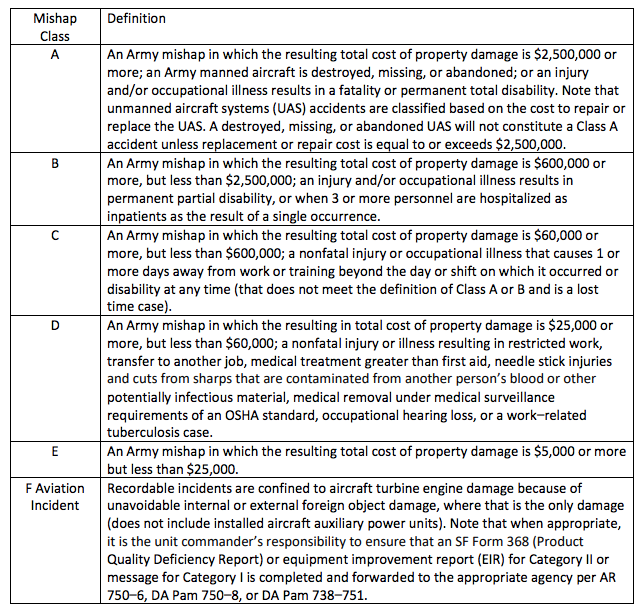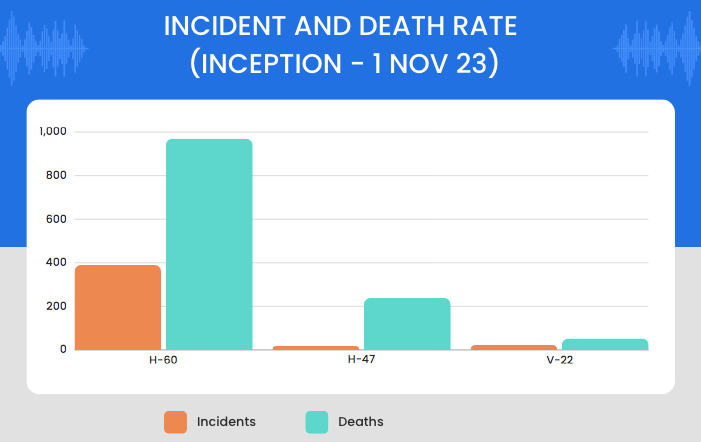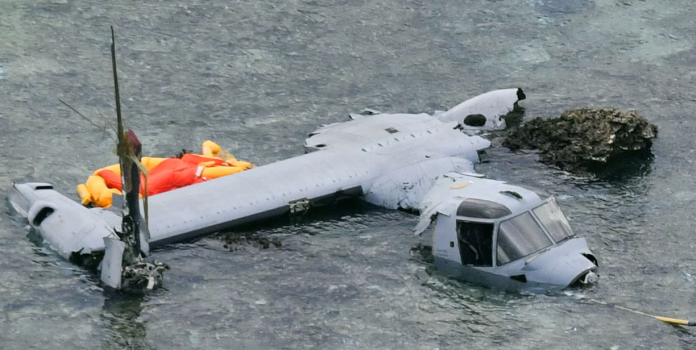This article was written by Aviation Identification, their page can be found here.
Airframes:
In accordance with the Tri-Service Aircraft Designation System, this article omits the modified mission code so that all variants in the described airframe category are included. For example, “H-60” includes the UH-60, MH-60, SH-60, VH-60, HH-60, EH-60, and all series of those craft. This criterion is applied to the V-22 and the H-47 and all variants and series.
Preface:
Even to the general public, the subject of the V-22 Osprey Tilt-rotor craft can be one of controversy. Its notoriously troubled development and early implementation is often cited for its guilt in the loss of over 50 Service Members’ lives. Countless forums, posts, and comments can be found across social media asking the same question: Why is the Osprey still flying?
The V-22’s first flight was in 1989 but didn’t enter until June 2007. Between those dates, 30 people lost their lives in V-22 incidents. The most infamous of which was the 2000 Marana crash. In April of 2000, 19 Marines loaded onto a V-22 with a simulated rescue mission. Upon an attempted descent into Marana Northwest Regional Airport in Arizona, the right rotor stalled at an altitude of 245 feet. This caused the aircraft to roll over, and crash into the ground upside-down ultimately being engulfed in flames. All 19 lives on board were lost. Vortex Ring State (VRS) was the determined cause of the crash. VRS is when a rotary wing aircraft descends at such a quick rate that it puts the blades into its own downwash (also called “turbulent” or “dirty air”) causing the blades to lose the ability to produce lift. At the time of the accident, the V-22 was restricted to a descent rate of 800 feet per minute (4.1 m/s). It is normal for aircraft in development to have operational flight restrictions, especially for new technology such as tilt-rotor, as it takes time to understand and develop an accurate flight envelope. It was determined that the pilots voluntarily descended too quickly, therefore determined as a pilot error. Since this incident, there has been an overwhelmingly negative view from Service Members and the general public alike towards the V-22 with papers, documentaries, and other products being produced in an attempt to have the airframe removed from service.
Incidents:
Incidents are characterized into six categories in accordance with United States Army Aviation. The US Navy and Marine Corps have an almost identical chart, but for the sake of comparison and comprehensibility, we will use the Army Aviation Chart, as there are no differences that will alter the results of the data.

Since 1991, there have been 25 V-22 involved incidents, 16 of which were hull loss incidents, seven were minor incidents and two were indirect deaths. Of these incidents, nine were determined to be pilot error, ten mechanical failures, one was a combination of both, and three are under investigation. Those under investigation include the recent Japan and Australia crashes and the 2017 Syria crash. The final two are omitted, as they cannot be directly linked to the V-22. All of these incidents are designated as Class A.
Summaries of Each Hull Loss Crash:
JUNE 1991
Faulty wiring of a flight control system caused the left engine nacelle to strike the ground while the aircraft was hovering at 15 feet. The pilot suspected that he accidentally set the throttle in the opposite position than intended.
DEATHS: 0
INJURIES: 2
RULING: Mechanical and Pilot error
JULY 1992
Pre-production V-22 #4 right engine failure causes the aircraft to violently fall into the Potomac River in front of industry officials and DoD observers. All onboard were killed.
DEATHS: 7
INJURY: 0
RULING: Mechanical failure of the right engine
APRIL 2000
Pilots descended too quickly, sending the aircraft into vortex ring state and stalling the right rotor causing the aircraft to roll upside down and crash.
DEATHS: 19
RULING: Pilot error
DECEMBER 2000
Vibration induced chafing of wiring harness which caused a leak in a hydraulic line, which fed the primary side of the swashplate actuators to the starboard rotor. Pilots attempted to reset the system eight times before the aircraft crashed near Jacksonville, North Carolina.
DEATHS: 4
RULING: Mechanical failure
MARCH 2006
An incorrectly wired cannon plug to one of the engine’s Full Authority Digital Engine Controls caused an uncommanded engine acceleration resulting in the aircraft going airborne about 2 meters before belly flopping onto the ground.
INJURIES: 0
DEATHS: 0
RULING: Mechanical failure
APRIL 2010
An MV-22B crashed near Qalat, Afghanistan while attempting to land. Investigators determined that an improper approach, loss of spatial awareness, high descent rate, and poor visibility caused the crash.
INJURIES: 19
DEATHS: 3
RULING: Pilot error caused by environmental factors
APRIL 2012
MV-22 crashed during joint training exercise “African Lion” in Western Africa, No mechanical faults were found with the aircraft.
INJURIES: 2
DEATHS: 2
RULING: Pilot error
JUNE 2012
CV-22 crash at Eglin Air Force base in Florida was determined to be caused by the aircraft flying through the prop wash of another aircraft.
INJURIES: 5
DEATHS: 0
RULING: Pilot error
MAY 2015
Dust intake caused the starboard engine to fail causing the aircraft to land violently and catch fire.
INJURIES: 20
DEATHS: 2
RULING: Mechanical failure
DECEMBER 2016
MV-22 crashes while attempting to land on a shallow reef off the coast of Okinawa. The aircraft broke apart. All five crew members were rescued. It was found that the Osprey’s rotors had clipped the refueling probe of an HC-130 and was the cause of the incident.
INJURIES: 2
DEATHS: 0
RULING: Pilot error
AUGUST 2017
MV-22 rotors clipped the USS Green Bay during take off from another ship and subsequently crashed into Shoalwater Bay off the East coast of Australia.
INJURIES: 0
DEATHS: 3
RULING: Pilot error
SEPTEMBER 2017
V-22 in Syria suffered a hard landing and subsequently caught fire and burned down.
INJURIES: 2
DEATHS: 0
RULING: UNK (under investigation)
MARCH 2022
“GHOST 31” crashes during exercise Cold Response in Gråtådalen, Norway. It was determined that steep bank angles at low altitudes that were outside of the operational envelope of the aircraft was the cause. Of significant note, a GoPro camera was found in the cockpits, which is prohibited due to fear that they might encourage dangerous behavior.
INJURIES: 0
DEATHS: 4
RULING: Pilot error.
JUNE 2022
Catastrophic drive system gearbox failure caused the aircraft to crash.
INJURIES: 0
DEATHS: 5
RULING: Mechanical failure.
AUGUST 2023
MV-22B crashes North of Darwin on Melville Island, Australia during “Operation Predators Run 2023”.
INJURIES: 5
DEATHS: 3
RULING: UNK (under investigation).
December 2023
CV-22B Crashes off the coast of Yakushima Island, Japan. Witnesses report seeing the aircraft inverted with the left nacelle engulfed in flames. The cause of the incident is under investigation.
INJURIES: 5
DEATHS: 3
RULING: UNK (under investigation).
Nine other incidents indirectly caused two deaths; a crew chief fell out of the back of a V-22 and a Marine drowned when his life vest failed to inflate after a V-22 crashed into the ocean. Of the seven remaining incidents, five were mechanical failures and two were pilot error.
Totals:
Pilot Error: 9
Mechanical Failure: 10
Both: 1
UNK: 3
Deaths: 58
Injuries: 52
Critics of the aircraft are quick to say that these numbers are far too high and that the V-22 should be pulled from service due to its unreliability and high death toll. On the other side of the argument, many have pointed out that the Osprey is the least dangerous when compared to other aircraft by deaths within the first 30 years of operation. Moreover arguing that the death toll and crash rates are less per flight hour than all other rotorcraft in the US inventory within the first 30 years of service.
Statistics
Due to limitations of information beyond 30 years, values from the H-47 are averages taken over a five-year study on each airframe and annotated by “ *”. The total available data is in the paragraph following the data of each aircraft.
V-22 (1989-2023)
- Years in Service: 14 (35 years when including years before official service)
- Incidents: 25
- Deaths: 58
- Total flight time: 600,000+ hours
- Airframes: 400
-Average incident per 100k flight hours: 4.16
-Average incident per airframe .0625
-Average deaths per 100k flight hours: 9.66
-Average death per airframe: .133
H-60 (2016-2020)
- Years in Service: 45
- Incidents: 390
- Deaths: 970
- Total flight time: 1,700,000+ hours
- Air frames: 5,000
-Average incident per 100k flight hours: 22.94
-Average incident per airframe .078
-Average deaths per 100k flight hours: 1.06
-Average death per airframe: .194
The H-60 accounted for 54% of the Army Aviation rotary wing fleet, 47.9% of all flight hours and 48.5% of rotary wing incidents during the period of 2016-2020 (Flightfax). While these values seem reasonable, since it’s inception in 1979, the H-60 and variants have suffered 390 incidents resulting in 970 deaths. 60 of those deaths have occurred in the past decade, meaning the H-60 is responsible for two more deaths in ten years than the V-22 is in 30 years.
H-47 (2016-2020)
- Years in service: 61 (covering 5 years)*
- Incidents: 47*
- Deaths: 0*
- Total flight time: 387,000*
- Air frames: 400*
-Average incident per 100k flight hours: 12.14* (other sources site a rate of 9.4)
-Average incident per airframe: .11*
-Average deaths per 100k flight hours: N/A*
-Average death per airframe: N/A*
H-47 accounted for approximately 12% of the Army Aviation rotary wing fleet, 11% of all flight hours, and 17.5% of all incidents with no deaths. The previous 5-year study completed on the H-47 had higher incident rates and one death. This suggests that the Army has taken action to reduce incident rates and increase safety. Also, the data shows that most incidents of the H-47 during this specific study were non-life threatening. The high safety record of the past decade is a new feat for Army Aviation; the H-47 has been prone to the highest death rate per incident in the Army. Over a 39-year period from 1966 to 2005, 238 people lost their lives in ten individual H-47 non-combat related crashes. Of note, these figures are just from the US inventory of H-47s and continue to grow when considering foreign fleets.
Interestingly, the aircraft with the highest incident rates (H-47) have the lowest average rates of death while the aircraft with the lowest incident rates (V-22) have higher death rates. While our data is good, it does not take into account the time each aircraft has been around, the novelty and complexity of each aircraft, or the research and development that went into each aircraft. These factors would require extensive testing in various atmospheric conditions and environments for every mechanical and electrical system on the craft. This data suggests a few things. First, we expect to see higher rates of death per incident with larger aircraft as they carry more people than smaller aircraft can, thus more people are exposed to deadly circumstances per incident, such as the V-22 or H-47 in comparison to the H-60. Second, as aircraft grow in complexity, we expect to see a density of incidents post-introduction period. The volume of incidents tapers off as the aircraft ages and unreliable systems in the aircraft are fixed and/or replaced. Third, the most telling piece of information we can obtain is the “incidents per airframe” as it takes into account the volume of the particular airframe and provides us with an estimated percent that an incident will occur on any given airframe of that particular model of aircraft.

All of this to say, if you could line up every H-60 in the US inventory at any point in history and pick one of them at random to fly in, there is a .05% chance it will experience a Class A through F incident. The V-22 has an incident rate of .06% putting it just .01% more likely to have any category of incident than the H-60. The H-47 is almost doubled with a .11% chance of an incident. The V-22 has been responsible for far fewer deaths than either the H-60 or the H-47 since its introduction in 1989. While aircraft will never be perfect, this data supports the idea that the distaste towards the V-22 for causing perceived mass amounts of casualties and putting Service Members’ lives at risk is a result of groupthink. A phenomenon in which a group of individuals comes to a consensus without critical reasoning or considering the consequences or alternatives.
Groupthink tends to have a negative connotation, but two factors in this specific situation make groupthink a good thing. Most importantly, tilt-rotor aircraft are still a relatively new technology, as previously stated, it takes time to develop safe flight parameters and to fully understand which systems and subsystems need adjusting or replacing. Second, the US government funds it. If a new aircraft was sold to airlines and was under as much scrutiny as V-22s are, airlines would never purchase the aircraft, resulting in the extinction of tilt-rotor aircraft. However, since the government funded the V-22’s development, it is also the government’s decision as to when to cease production due to safety concerns. Government projects usually only get canceled due to cost overruns or if the project is deemed outdated by a more advanced design. It’s less common in history to see government projects be canceled due to safety concerns. This is not to say safety has been neglected, it’s simply more common that cost or advancing technology cease the project before it even makes it to full-scale mockup, much less operation. I would argue in this particular case, groupthink is one of the few forces holding manufacturers accountable. By holding organizations under the microscope of scrutiny and with the rise of the common person being able to post a video to an audience of billions, I think, have, and will continue to pressure the defense industry into more robust and reliable systems. However, this particular instance is also confusing as the V-22 is, and as we have observed, one of the safest aircraft in the US inventory. Therefore, instead of asking why V-22’s are still flying, I propose the question: why Service Members aren’t holding similar aircraft to the same standard?
With the United States Army choosing the V-280 Valor tilt-rotor over the SB>1 Defiant coaxial helicopter to replace the H-60 line, it’s clear that the US has no plans to replace tilt-rotor technology. Conventional helicopters are cheaper to produce and procure, they’re smaller, and as a result, they require less space to land and store, they can hover for longer periods, are quieter, more stable, less complex, cheaper to maintain, and cheaper and easier to train pilots and crews on. While it seems as though the advantages lie entirely with conventional design (complexity grows with coaxial but remains less complex than tilt-rotors), there are two major benefits that tilt-rotors offer; speed and range. The V-22 can cruise at nearly twice the maximum speed of the H-60 and its operational range (operational range is distance allowed during combat operations, not maximum range) is 70 miles (113 km) further than the H-60. That means in the time it would take an H-60 to fly its operational range one way, the V-22 could’ve already conducted its mission and be on approach for landing back at base. This speed and range allow for the greater standoff of a carrier task force or land forces, creating an ability to conduct combat operations and influence the region while keeping the majority of the force outside the range of enemy weapons. These attributes are not just reserved for combat roles either. A variant of the V-22 is currently replacing the C-2 Greyhound. The C-2 is a light cargo plane that is vital to carrier operations as it flies in spare parts for aircraft, keeping naval aviation in the fight, and the task force protected. However, the C-2 is limited to runways. If a spare part was needed, the C-2 would have to fly to a land-based airstrip to retrieve the part, often requiring it to fly further than the actual nearest base. In comparison, the V-22 can go directly to the nearest base instead of the nearest runway, significantly reducing fuel consumption and time taken to repair equipment. While the V-22 has seen combat in Afghanistan and Iraq, just as any other new piece of military equipment, the V-22 has not seen combat against a peer or near-peer threat. While its speed and range have been significant advantages in non-combat and GWOT environments, we do not know if they outweigh the advantages of conventional helicopter design in a combat environment that would resemble the Russo-Ukraine war.
Sources
H-60 Safety: H-60 Five-Year Mishap Review FY14 – FY18. safety.army.mil. (n.d.-b). https://safety.army.mil/Portals/0/Documents/ON-DUTY/AVIATION/FLIGHTFAX/Standard/2019/Flightfax_75_March_2019.pdf
H-47 Safety: Chinook Safety Performance Review. safety.army.mil. (n.d.). https://safety.army.mil/Portals/0/Documents/ON-DUTY/AVIATION/FLIGHTFAX/Standard/2019/Flightfax_84_December_2019.pdf


